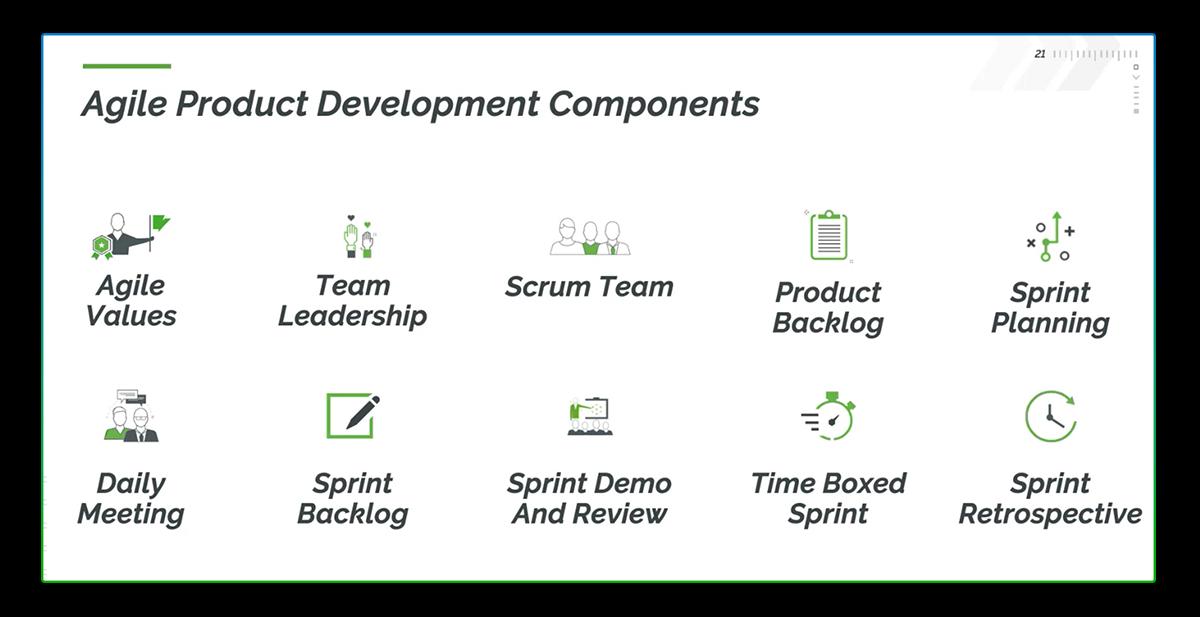
5:11
Have you ever seen agile product development in action?
In an Onshape User Group meeting, industry veteran George Lewis discussed the transformative impact of on product development. Lewis highlighted how three companies benefit from agile practices and offered practical implementation strategies for hardware developers to embrace these principles effectively.
Now’s the Time for Agile in Product Development
Traditionally associated with software development, agile methods are now being adapted for hardware. Why?
The current market demands rapid innovation and deployment, and agile development allows companies to iterate quickly, reducing the time from concept to market. This speed is crucial in maintaining a competitive edge, especially when product quality can’t be compromised.
“In the last few years, this is becoming a very common concept that customers want to begin to talk about,” Lewis said.
Also driving interest in agile is the increased complexity found in modern products with integrated software elements.
“Once upon a time, a door lock was a relatively simple mechanical device, and now it's got firmware, printed circuit boards, embedded systems,” he said as an example of growing product complexity.
Benefits of Agile Product Development at Any Level
Lewis presented real-world examples illustrating how companies such as Sonos, Sleep Me, and Ocado have reaped the rewards of agile methodologies, whether they have fully embraced all aspects of the methodology or implemented only certain elements.
Agile in Action: Sonos
Sonos, a producer of audio products, operates without a claim of full agile implementation. However, it exemplifies an initial level of agility by engaging with its supply chain early in the development process.
Utilizing cloud PLM to identify alternative material sources upfront, Sonos enhanced its supply chain resilience and avoided shipment delays. This demonstrates a foundational aspect of agility: early supply chain involvement, informing decisions, and streamlining processes.

Agile in Action: Sleep Me
At Sleep Me, a company specializing in heat pump technology for beds, the product development team is taking a foundational step toward agility.
By embracing the agile framework with sprint backlogs and time-boxed sprints lasting three to four weeks, Sleep Me achieved a 50 percent reduction in design cycle times, as shared by Lewis. This agile approach facilitated rapid learning and early challenge resolution, fostering accelerated innovation and problem-solving.
Moreover, Sleep Me has successfully blended agile with elements of the traditional waterfall approach, recognizing the importance of certain aspects as products approach production stages. The company's agile implementation also emphasizes rapid prototyping, aligning with the agile principle of showcasing tangible results at the end of each sprint.

Agile in Action: Ocado
Ocado Technology, a developer of robotics and automation for the online grocery industry, has pushed the limits of agile methodologies in product development. The company has implemented a strategy of releasing new hardware updates every three weeks, showcasing an agile and iterative approach in the earliest stages of development.
Ocado's utilization of agile, especially with the support of cloud-native tools like Onshape and other technologies such as Miro and Slack, has enabled them to achieve unprecedented levels of innovation. Ocado’s emphasis on three-week sprints for new hardware releases reflects the commitment to rapid iteration and continuous improvement.
The agile practices at Ocado not only demonstrate speed in product development but also highlight the significance of parallel collaboration among multiple teams. The company's ability to release new products at such a frequency suggests high adaptability and responsiveness to evolving market demands.
Implementing Agile in Product Development
As the discussion delved into practical implementation, Lewis emphasized the flexibility of agile adoption.
“There's no one way. I'm not here to tell you there's just one path to get there,” he said.
The agile journey, he explained, varies for each organization, allowing companies to implement one or two agile capabilities or push the limits with a comprehensive agile approach.

Let’s explore several ways hardware companies can become more agile.
Early Supply Chain Engagement
Agile places a significant emphasis on early involvement with the supply chain. Hardware companies are encouraged to collaborate with strategic suppliers in the initial stages, gaining valuable insights into design for manufacturability and proactively addressing potential hurdles.
Iterative Design in Early Stages
Breaking away from traditional approaches, agile suggests a shift towards iterative design, particularly in the early phases. This entails more time upfront to understand the product, explore alternative components, and make informed decisions, fostering resilience.
Flexible Design Effort
A departure from the conventional last-minute rush to meet production deadlines, agile proposes front-loading the design effort. This involves more iterations in the preparatory stages, allowing companies to reduce risks by making thoughtful decisions early on.
“Iterate early on and think heavily about the choices you make,” Lewis said. “I would argue spending a little bit more time in those early stages to gain knowledge and better understand your product and build in some resiliency in those early stages makes the most sense.”
Time-Boxed Sprints and Collaboration
While agile introduces time-boxed sprints, hardware companies may need to tailor the duration to suit the unique challenges of hardware development. The key lies in fostering collaboration within cross-functional teams, working in parallel to address challenges efficiently.
Sprint Demos and Reviews
Agile advocates for showcasing achievements at the end of sprints. For hardware companies, this translates into presenting prototypes or virtual demos and seeking valuable feedback from stakeholders, including manufacturers and suppliers.
Sprint Retrospectives for Continuous Improvement
A cornerstone of agile is the retrospective at the end of sprints. Hardware companies are encouraged to conduct retrospectives to refine and improve their agile processes, recognizing that the early stages may present unique challenges.
Leadership Support and Cultural Alignment
For successful agile implementation, unwavering support from leadership, including executives and founders, is paramount. Aligning the organizational culture with agile values ensures widespread acceptance and adoption at all levels.
Flexible Implementation of Agile Capabilities
Agile is not a one-size-fits-all solution. Companies can cherry-pick specific agile capabilities that align with their goals, whether adopting a few or embracing comprehensive agile practices.
Cloud-Native Tools for Better Collaboration
Agile implementation is further facilitated in the era of cloud-native tools like PTC’s Onshape and Arena. These tools are pivotal in enhancing collaboration, especially in the early stages of product development, fostering iterative design and seamless team communication.
Try Onshape Today
Head to our sign-up page to choose the right CAD plan for you and your team.
Latest Content

- Case Study
- Industrial Equipment & Machine Design
Reframe Systems: Transforming Homebuilding with Digital Automation and Cloud-Native Onshape
09.25.2025 learn more
- Blog
- Becoming an Expert
- Assemblies
- Simulation
Mastering Kinematics: A Deeper Dive into Onshape Assemblies, Mates, and Simulation
12.11.2025 learn more
- Blog
- Evaluating Onshape
- Learning Center
AI in CAD: How Onshape Makes Intelligence Part of Your Daily Workflow
12.10.2025 learn more
- Blog
- Evaluating Onshape
- Assemblies
- Drawings
- Features
- Parts
- Sketches
- Branching & Merging
- Release Management
- Documents
- Collaboration
Onshape Explained: 17 Features That Define Cloud-Native CAD
12.05.2025 learn more



